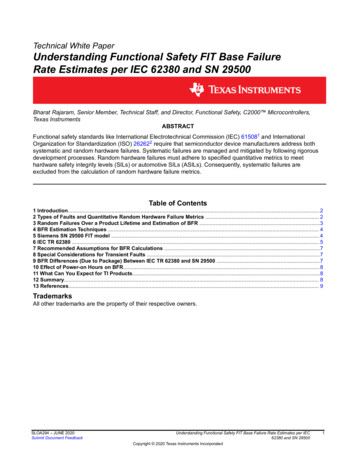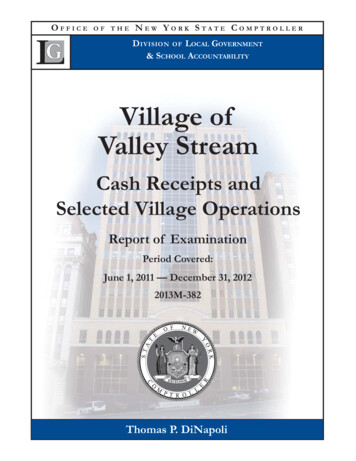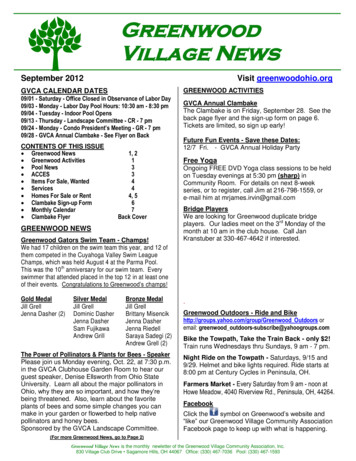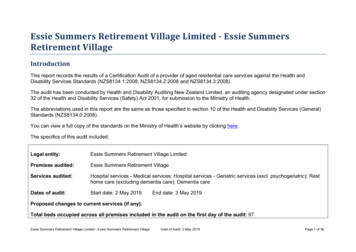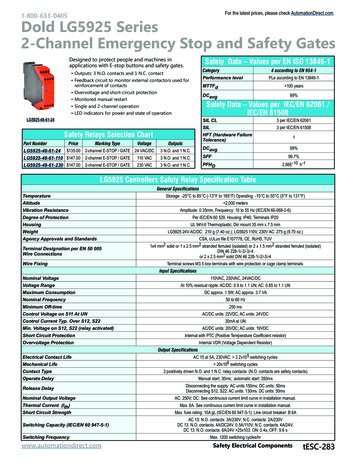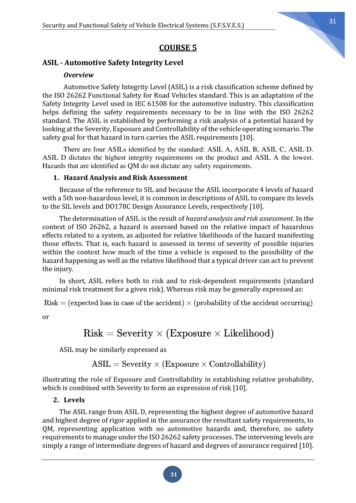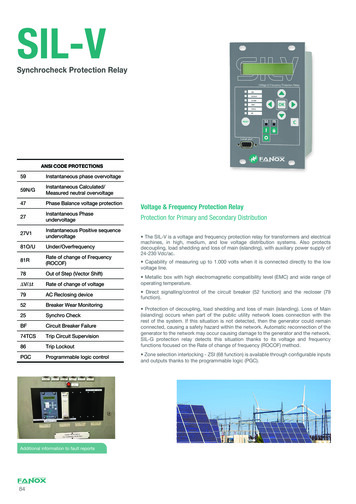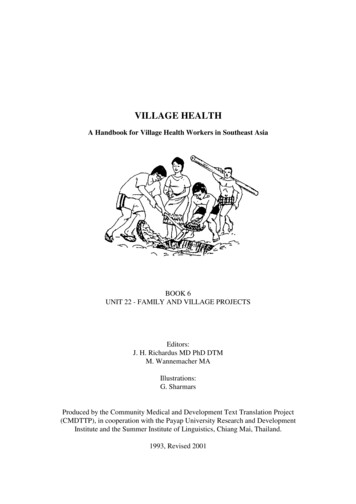
Transcription
VILLAGE HEALTHA Handbook for Village Health Workers in Southeast AsiaBOOK 6UNIT 22 - FAMILY AND VILLAGE PROJECTSEditors:J. H. Richardus MD PhD DTMM. Wannemacher MAIllustrations:G. SharmarsProduced by the Community Medical and Development Text Translation Project(CMDTTP), in cooperation with the Payap University Research and DevelopmentInstitute and the Summer Institute of Linguistics, Chiang Mai, Thailand.1993, Revised 2001
VILLAGE HEALTHA Handbook for Village Health Workers in Southeast AsiaBOOK 6UNIT 22 - FAMILY AND VILLAGE PROJECTSEditors:J. H. Richardus MD PhD DTMM. Wannemacher MAIllustrations:G. SharmarsProduced by the Community Medical and Development Text Translation Project(CMDTTP), in cooperation with the Payap University Research and DevelopmentInstitute and the Summer Institute of Linguistics, Chiang Mai, Thailand.1993, Revised 2001
VILLAGE HEALTHThe "Village Health" English version consists of 6 books:Book 1: Introduction and Translation ManualBook 2: Unit 1 - The Village Health WorkerUnit 2 - How to Prevent Many Health ProblemsUnit 3 - NutritionUnit 4 - How to Take Care of Sick PeopleUnit 5 - First AidBook 3: Unit 6 - The Body and How the Body WorksUnit 7 - Introduction to SicknessUnit 8 - How to Examine a Sick PersonUnit 9 - How to Use MedicinesBook 4: Unit 10 - Signs IndexUnit 11 - List of SicknessesUnit 12 - Dehydration, Diarrhea and VomitingUnit 13 - Skin ProblemsUnit 14 - Eye ProblemsUnit 15 - Teeth, Gums and MouthBook 5: Unit 16 - Family PlanningUnit 17 - Women's Health, Pregnancy and ChildbirthUnit 18 - Health and Sickness of ChildrenUnit 19 - How to Prevent DisabilitiesUnit 20 - Health and Sickness of Old PeopleUnit 21 - AddictionBook 6: Unit 22 - Family and Village ProjectsPublished by: Payap Research and Development InstituteLPO, Chiang Mai 101Chiang Mai 50000ThailandAny part of this book may be reproduced or adapted for local use without thepermission of the editors provided that the material is used for non-profit purposes.The books "Where There is No Doctor" by Dr. David Werner and "TheVillage Medical Manual" by Dr. Mary van der Kooi, were a valuable resource in thedevelopment of this material. Many chapter outlines have been adapted from thesebooks, and many drawings have been borrowed or adapted from "Where There is NoDoctor" which we gratefully acknowledge. We have adapted material and borroweddrawings, pages 16b, 20c, 21a, 22-25, for this unit from the "RegenerativeAgricultural Technologies Training Kit" by the International Institute for RuralReconstruction, which we gratefully acknowledge.
If you are interested in translating this book, please contact the editors at thefollowing address:Mark Wannemacher, CMDTTPP.O. Box 246Chiang Mai 50000ThailandThis book series has currently been translated into Thai, Jinghpaw, Rawang,Burmese, Sgaw Karen, and Lisu.Community Medical and Development Text Translation Project (CMDTTP)StaffCMDTTP Coordinator: Mr. Mark Wannemacher, MA, Linguist, Summer Institute ofLinguistics and Payap University Research and Development Institute.CMDTTP Medical Coordinator: Dr. Jan Richardus, MD, PhD, DTM, McKeanRehabilitation Center.CMDTTP Development Coordinator: Mr. Matthew Mann, Community DevelopmentWorker, Thailand Baptist Missionary Fellowship.CMDTTP Artist: Mr. Gordon SharmarsWe would like to thank the following individuals for their input and contribution to"Village Health":Dr. Ed McDaniels, MD, McCormick Hospital, Chiang MaiAacharn Prasert Bhandhachart, Director, Payap Research and Development InstituteDr. Joseph Chiu, MD, World ConcernDr. Linda Morse, DO, Northern Thailand Christian MissionDr. Edward Riggs, MD, United Church Board for World Min.Dr. Ursula Loewenthal, MD, Phayao Bible SchoolDr. Prawate Khid-arn, Director, Development Division, Payap Research andDevelopment InstituteMiss Mary Ann Minsek, MPH, RD, Food for the Hungry Int.Mr. Klaus Prinz, Development Consultant, McKean Rehabilitation CenterMr. Shigio Asai, Development Consultant, McKean Rehabilitation CenterMr. Nathan Knoll, Payap Research and Development InstituteMr. Martin Culy, Linguist, Summer Institute of LinguisticsFinally we acknowledge the generosity of the Ambassador of the RoyalNetherlands Embassy in Bangkok for generously funding the production of theinitial English version of the manual.
TABLE OF CONTENTS - BOOK 6:Unit 22 - Family and Village ProjectsVillage Health TrainingHow to Dig and Use a Garbage PitHow to Make a Sand and Charcoal Water FilterHow to Make and Use a LatrineAccident Check and Village Clean UpHow to Make Pole GuardsHow to Keep the Water Supply CleanFill in and Drain Standing WaterCollecting Rainwater for DrinkingKeeping Animals in a FenceHow to Make Natural FertilizerFamily and School GardensSome Suggestions about SeedsTaking Care of Young FruitGrowing Crops TogetherPlanting Plants Along Your FencesPlanning Your CropsMaking Barriers to Prevent Erosion and IncreaseWater for Hill FarmingHow to Use Pesticides12367910111213131417202121222225
Unit 22 – Family and Village ProjectsUNIT 22FAMILY AND VILLAGE PROJECTS[How do most people measure things? Be sure to convert to common measurements.]There are projects that a family can do together to make their home a moresafe and more healthy place to live. There are projects that the people in a village cando together to make the village a more safe and healthy place to live.[Who should be involved in planning projects? Who should be involved in doingprojects? When do local people normally meet to discuss things?]The village health worker should talk with the village leaders to organize theprojects. The village leaders can choose a village health committee to oversee theprojects. The village health worker should encourage people to help with the projects.The village health worker should help people do the projects.[Try to make the projects fun. You can arrange food or music for the peoplewho work. Try to involve many people in the projects. School children can do a lotof work and make it fun. If people make something themselves, then they are morelikely to use it.]All of the material for these projects should be available to you locally. But, ifthe material is not available, do not stop trying to solve the problem. Think of newways to make the village a safer and healthier place to live. Try to find someone withexperience to help with each project. But, if you do not know anyone withexperience, you can still try to do the project yourself.VILLAGE HEALTH TRAININGThe village health worker's most important job is to teach people how toprevent and treat sickness. You can meet with each family or have a village meeting.You can train 1 or 2 assistants who learn and teach others about specific things. Forexample, in many cultures it is good to train a woman to treat and check pregnantwomen, to assist with the delivery of babies and to care for women after they have ababy.1
2When you teach, be sure people have the opportunity to practice what youteach them. For example, if you teach people how to make rehydration drink, thenshow them how to make the drink, then watch them make the drink and correct themif necessary. Be sure the people you train know how to do the things that you teach.The people you teach should demonstrate the method for you or be able to answerquestions that show they understand the information. Only teach one thing at a time.Here are some examples of information you can teach to families or groups.Use your "Village Health" manual to help teach the information. Decide what thepeople need to learn first.* Teach mother's how to give medicines to children.* Teach families how to use medicines properly.* Teach everyone basic information on how to take care of sick people.* Teach mother's how to make and use rehydration drink.* Teach pregnant women how to have a healthy pregnancy and how to care for anewborn child.* Teach mother's how to feed young children and how to recognize signs of sicknessin young children.* Teach families about good nutrition.* Have 1 day each month when women bring children under 5 to check their weightand check for health problems. Teach one new idea each month.* Teach families how to care for wounds and how to prevent accidents.* Teach people how sickness spreads and how to prevent sicknesses. Be sure toinclude the benefits of being healthy.* Teach people how to do the projects in this unit.HOW TO DIG AND USE A GARBAGE PIT[How do people dispose of garbage?]A garbage pit will help keep the village clean and take away food and hidingplaces for rats, flies and mosquitoes. A garbage pit keeps garbage away from thehouse. This helps keep away the rats, flies and mosquitoes that cause sickness. Agarbage pit will also help prevent accidents if you bury dangerous or sharp garbage.1. Choose a place that isconvenient for you walk to, butat least 20 meters from anyhouse. Choose a place that is atleast 100 meters from the villagewater supply. Dig the pit in aplace that water does not stay inafter it rains.
Unit 22 – Family and Village Projects2. You need to decide how big to dig the pit. During the dry season you can dig alarge pit since it will not fill with water. During the rainy season you might want todig a smaller pit that will hold the amount of trash you make in 1 or 2 weeks.3. Dig the pit and keep the dirt in apile next to the pit.4. Put your garbage in the pit each dayand cover it with a small layer of dirt.If you have a natural fertilizer pile, besure to put the trash that is useful forfertilizer on the fertilizer pile.5. If you put a fence around the pit,children will not fall in and animalswill not get into the garbage.6. When the pit is full, cover the pit with dirt. Next dig a new pit.7. The village leaders should assign someone to make sure everyone puts theirgarbage in the pit. Someone should be responsible to take care of the pit, be sure thegarbage is covered and be sure the fence is repaired.HOW TO MAKE A SAND AND CHARCOAL WATER FILTER[What is the source of drinking water? ]A sand and charcoal water filter takes some germs out of the water. The waterfrom a water filter is cleaner than water from the river or well.1. Get a large metal barrel, clay jar or other large container.2. Scrub the container with soap and water.3. If you use a metal barrel, paint the inside so that it does not rust.3
44. Make a hole near the bottom of the container for aspigot or pipe to go in.5. Put in the spigot. For a metal barrel, weld the spigot to the drum or use rubberseals. For a clay jar, seal the spigot with wax or sealer.6. Put the container in the place you will keep it. It will be very heavy to move whenyou are finished. Be sure the filter is high enough to put a water container under thespigot.7. Collect enough large gravel (approximately 2 - 4 cm wide) to fill 20 cm of thecontainer. Collect enough small gravel (approximately 1/2 – 1 cm wide) to fill 10 cmof the container. Collect enough sand to fill 1/2 of the container. Collect the sandfrom a river bottom and keep it wet all the time. Wet sand from a river bottom hasgood germs that will help kill bad germs. Wash the gravel before you use it.8. Put large gravel in the bottom of the container until itcovers the hole.9. Put about 10 cm of small gravel on top of the largegravel.
Unit 22 – Family and Village Projects10. Crush some charcoal until it is the size of smallgravel. Put about 10 cm of charcoal on top of the smallgravel. You can also use burned rice husk.11. Put enough wet sand over the charcoal to fill about 1/2 ofthe container.12. Put 10 cm of large gravel over the sand.13. Put a flat rock on top of the large gravel.14. Fill the container with water and let all thewater flow out to clean the gravel, charcoal andsand. Do this until the water looks clean.How to use the water filter:1. Fill the container with water and open the spigot when you want to get clean water.2. Fill the container often. Do not let the sand dry out. If the sand dries out, then thegood germs will die.3. Cover the filter with a lid when the filter is not used. This will keep dirt, bugs andmosquitoes out of the water.4. If the water that you want to filter is very dirty, then let the water sit for 10 minutes.Then pour the clear water into the filter and throw away the water at the bottom of thecontainer.5
65. Dirt and germs can fill in the spaces between the sand and make the water flowslowly. If the water comes out of the filter very slowly, take out the top layers ofgravel and about 1/2 of the sand. Wash the gravel and sand with water and then putthem back into the filter the same as before.6. Store the filtered water in a clean, covered container.HOW TO MAKE AND USE A LATRINE[Where do people in the village defecate? What are the obstacles to using latrines?]When people use latrines, they prevent pigs and flies from eating feces andspreading sickness. When people use latrines they make the village cleaner. But, allor most of the people in the village must agree to use a latrine when they defecate. Ifonly a few people use latrines, there will still be a lot of feces on the ground for fliesand animals to eat and spread sickness.Tell the village leaders why all people should build and use a latrine. Thevillage leaders can be sure everyone has a latrine. You must also teach people how touse a latrine. A latrine is no good if people do not use it.How to make a latrine:1. Choose an area about 20 meters from houses, rivers and water supplies.
Unit 22 – Family and Village Projects2. Dig a hole about 1/2 to 1 meter wide. Dig the hole 1-2 meters deep.3. Cover the hole with a bamboo, wood orconcrete cover. The cover should have a 30 cm(10 inch) hole in the center.4. Make a wood lid to go on top of the hole to keepflies out of the latrine.5. Build a small house around the latrine.6. Keep water for washing the buttocks [orpaper/leaves for wiping] in the latrine house.How to use a latrine:1. Take the lid off the latrine hole.2. Defecate in the latrine hole.3. After you defecate, throw some dirt, ash or lime in the hole to reduce the smell andhelp cover the feces.4. Put the lid back over the latrine hole.5. Keep some water and soap outside of the latrine for people to use to wash theirhands after they defecate. It is best if the water flows or is poured onto the hands.6. Keep the latrine clean. Wash the floor often. Teach children how to use the latrineand teach children not to defecate on the floor.7. When the latrine is full, dig a new latrine. Use the dirt from the new latrine tocover the old latrine hole. Use the old latrine cover and lid for the new latrine. Youcan also use the same latrine house.Be sure the school and church also have a latrine. There are many otherdifferent kinds of latrines. Check with people about what is available in your area.ACCIDENT CHECK AND VILLAGE CLEAN UPAll villagers should help keep the village clean. People in a clean village haveless sickness and less accidents. A village committee, school group or church groupcan help make sure the village stays clean. The committee should check the villageand places that the villagers commonly use, such as the area to collect water, thebathing area, and trails.7
8The committee should look for the following things:* Sharp or dangerous objects left on the ground.* Broken glass.* Dogs or animals that try to bite people.* Areas with a lot of garbage, especially garbage that attracts flies and rats.* Areas where rain washes animal or human feces into the water supply.* Poisonous plants.* Steep areas where children play.* Areas where there is standing water.* Areas where the water is deep and children can drown.The committee should make a list of the dangerous or unhealthy things. Theycan present the list to the village leaders and decide how to solve the problems.Each family should do the same check inside and around their house. Insidethe house, the family should check the following:* Is the fire in a place where small children cannot get burned?YesNo* Are medicines, kerosene and chemicals kept where children cannot get them?YesNo* Are there rails around the house to stop children from falling off?
Unit 22 – Family and Village Projects* Are sharp and dangerous objects such as guns, knives and tools kept wherechildren cannot get them?YesNo* Are electrical wires covered with insulation or electrical tape to prevent electricalshock?The family should work together to make the house a safe place for everyone,especially small children.HOW TO MAKE POLE GUARDS[Is sheet metal available?]Rats spread sickness and eat people's food. Pole guards keep rats fromclimbing poles and going into the house, cooking house and food storage containers.When the rat tries to climb the pole, the rat cannot climb past the pole guard.Some pole guards attach to the pole at the top and are wide at the bottom. Youcan use an old bucket without a bottom for this type. The easiest pole guard to makeis a piece of tin wrapped around the house poles. The rats cannot dig their claws intothe tin and cannot climb past the tin. You must put a pole guard on every pole thatattaches to the ground to keep rats out.1. Cut the bottom out of an old bucket. Next cutthe side. Wrap the bucket around the pole with thewide part down. Nail the narrow end to the pole.9
10or2. Cut a piece of tin about 35 cm (1 foot)high and wide enough to go all the wayaround the house pole. Nail the tin to thepole where the tin overlaps at the top andbottom. You can also put pole guards oncoconut and fruit trees to prevent ratsfrom eating the fruit.HOW TO KEEP THE WATER SUPPLY CLEAN[What is the most common water source? Where is it located?]The village leaders should select a person to care for the village water supply.This person is responsible to keep the area around the water supply clean, to build andrepair the fence around the water supply and to make sure people use the water supplyproperly.If the water supply is a well, build awall around the hole with concrete or bricks.This will stop rainwater from washing fecesand garbage into the well. Someone shouldclean the dipper or bucket every week.If you collect water from a spring, thenput a fence around the spring. Do not letanimals graze uphill from the spring. Build asmall concrete or brick wall above and aroundthe spring on 3 sides to keep out rain waterthat washes down the hill.
Unit 22 – Family and Village ProjectsIf people collect their water from the river, they should collect the water fromthe highest place on the river near the village. Everyone should agree not to defecate,wash clothes or bathe at that place or above that place. Keep animals away from thatplace. Animals should graze downhill from the water supply. If possible, put a fenceup to keep animals away from the water supply.FILL IN AND DRAIN STANDING WATERMosquitoes spread many sicknesses such as malaria, dengue fever andencephalitis. Mosquitoes breed in water. Fill in and drain standing water to reducethe number of mosquitoes in the village and reduce sickness that mosquitoes spread.If you dig small trenches leading downhill, then you will drain water away.You can use the dirt from the trenches to fill in smaller areas that hold water. Be sureto drain or fill in wet areas under houses. Some wet areas are good places to plant afamily garden.11
12Dig shallow trenches around houses that have floors on the ground to drainrain water away from the house.Mosquitoes can breed in only a little water. Fill in bamboo fence posts withsand. Cover all water containers, wells and latrine holes. Mosquitoes can breed in thewater under tall grass. Cut all tall grass near the village.After it rains, check around each house and the village. Fill in or drain placesthat have standing water. The village leaders should choose a person to be responsiblefor draining and filling places with standing water.COLLECTING RAINWATER FOR DRINKING[Are there any cultural beliefs about rain water?]Rainwater is clean and good to drink. There are many ways to collectrainwater to drink. Here is one way to collect rainwater to drink. You can think of away that is best for your house.1. Split bamboo and put thebamboo along the edge of the roofso that rainwater from the roofwill run into the bamboo. Thebamboo should slope down tomake the water flow into a storagecontainer.2. Let the water from the roof flow onto the ground for a few minutes so that therainwater will clean the roof and the bamboo. Then move the bamboo spout to makethe water flow into the container.3. Keep the water storage container covered. If the water stays in the container for along time, then germs will grow and the water will not be clean. You should clean thecontainer every 3-4 weeks during the rainy season. Drain the container and scrub thesides, top and bottom of the container. You can also put a sand-charcoal filter wherethe water comes out to help clean the water before you drink the water.If there is no rain for a long time, or if the water in the container is dirty, thenyou can make the water clean other ways. Boil dirty water 10-15 minutes before youdrink the water. If you do not have enough wood to boil the water, you can add 4drops of 2% tincture of iodine to each 1 liter of water. Wait 1/2 hour and then you candrink the water. The iodine kills the germs. Do not use more tincture of iodine thansuggested.
Unit 22 – Family and Village ProjectsKEEPING ANIMALS IN A FENCE[Where are animals kept?]Germs in animal feces spread sicknessessuch as hookworm and diarrhea. Do not letanimals walk around and defecate in the village.Build fences and keep the animals in the fences.Rain water washes animal feces into the watersupply. Be sure to keep animals below the placewhere you collect water.HOW TO MAKE NATURAL FERTILIZERYou can make natural fertilizer for your gardens and crops using manure, plantand animal garbage and plant materials. Natural fertilizer makes the soil stronger,makes your plants grow better and is much cheaper than chemical fertilizer.Materials You Can Use to Make Natural Fertilizer:dry leavesgreen leavesplant stalksfruit and vegetable peelingsbark and branchesfruit coresanimal manuresawdusthaircorn cobsnut shellsfeatherseggshellsashescoffee groundsseed podscorn husksdry grassrice strawpeanut shellsany other plant materialHow to Make Natural Fertilizer1. Gather and save enough material to fill your natural fertilizer pit. Collect manureand cover the manure to help prevent drying. Begin making your natural fertilizer pitat least 9 weeks before you plant your garden or crops.2. Choose a location for the pit near yourgarden and near a water source. Dig a hole 1meter (3 feet) deep, 1.3 meters (4 feet) wideand 1.3 meters (4 feet) long. Build a fencearound the pit to keep the fertilizer in andanimals out. If possible, cover the inside ofthe pit with plastic.13
143. Put a 15 cm (6 inch) layer of chopped plantmaterial and food trash on the bottom. Then add 8cm (3 inches) of animal manure. Next add 3 cm (1inch) of good soil from an area outside of the garden.Repeat the layers in the order above until the pit isfull and 30 cm (1 foot) above the ground.4. Add water until all the material is wet. Cover the material with banana leaves.Never let the material dry out. Add water when necessary to keep the material moist.Sunlight makes the fertilizer weak. You can build a roof over the pit or dig the pitunder a tree to reduce the heat from the sun.5. The material will get hot inside. After about 3 weeks dig the material out and mixit again, then put it back into the pit. Do this every 3 weeks until the material is darkbrown. The natural fertilizer should be ready to use in 6-9 weeks. You can also makenatural fertilizer without digging a pit. To do this, put the material in a pile andfollow the steps above.6. Put 1/2 a finger length (1 ½ inches) of the natural fertilizer on your garden or in theholes for planting. Be sure to mix the fertilizer with the dirt in the gardenimmediately. It is best to spread the fertilizer on a cloudy day because the sun driesthe fertilizer and makes the fertilizer weak.There might not be enough material in the village area to make naturalfertilizer for everyone. Discuss this situation with village leaders if necessary.FAMILY AND SCHOOL GARDENS[What vegetables grow best in the area? What seeds are available? Where do peopleget their vegetables?]Every family and every school should have a vegetable garden. Eatingvegetables helps a person stay healthy and fight sickness. A small garden can provideenough vegetables to eat all year. Children in the school should help to prepare andcare for the school garden. The children can eat the vegetables with their schoollunches.What to PlantPlant vegetables that are nutritious and easy to grow in your area. Plantvegetables that you harvest at different times so that you will have some vegetables allthe time. Try to plant vegetables that give you many parts to eat such as the leaves,roots, and flowers. You should plant vegetables that give you energy and differentvitamins.
Unit 22 – Family and Village ProjectsVegetables that give us energy are: potato, sweet potato, rice, some beans, corn.Vegetables that have vitamin A and help prevent night blindness are: peppers,spinach, pumpkin, sweet potato leaves, squash.Vegetables that help build the body are: various beans, peanuts, soybeans.Vegetables that have vitamin C and help prevent sickness are: mustard, spinach,horseradish, onions.Vegetables that have iron and help prevent anemia are: peas, various beans, sweetpotato leaves, spinach, pepper leaves, dark green leafy vegetables.Also be sure to plant some fruit trees such as papaya, mango, banana and otherfruits that grow well in your area.Some plants that have a strong smell help repel insects. Mint, onions, garlicand marigolds help repel insects. Plant some of these around your garden.When to PlantSome vegetables grow for a long time before you can harvest them. Somevegetables grow for a short time. Plant some vegetables that grow for a long time andsome vegetables that grow for a short time so you will always have vegetables. Makea small garden to grow seedlings and plant the seedlings when you harvest anothervegetable from the main garden. The best time to plant is different for different areas.Ask a local farmer for help.Some vegetables that grow for a short time are:Lima beans - 50-65 daysLeaf lettuce - 30-40Mustard - 30-40String beans - 40-70Cucumber - 35-45Some vegetables that grow for a long time are:Cabbage - 60-70 daysCorn - 68-70Peas - 65-70Squash - 75-100Tomato - 70-100Peppers - 90-110Onions - 90-150Sweet potato - 90-120Garlic - 100-140Various beans - 65-75How to Plant Your GardenThere are many ways to plant a garden. You should check with local farmersabout what works best in your area. Here is one way to plant your garden.1. Find the best place for your garden. The area should have consistent sunshine,fertile soil, a good water supply and good drainage.15
162. A garden that is 6 meters wide and 12 meters long can provide vegetables for afamily of 6 people all year. If you build a platform at one end of the garden, thenpumpkin, squash, and vines can grow up the platform. You can plant vegetables thatlike shade under the platform (ginger, peppers and sweet potatoes). Make a naturalfertilizer pit at one end of the garden to provide natural fertilizer. Make the gardenlarger or smaller depending on the number of people you need to feed.3. Dig and break up the soil in the garden 15-20 cm (6 or 8 inches) deep. Then dividethe garden into sections about 5 meters long (5 1/2 yards) and 1 meter (1 yard) wide.Dig a ditch around each section about 20 cm (8 inches) deep and about 30 cm (11inches) wide. Pile the dirt on the ground inside the garden.4. Mix natural fertilizer with the soil before you plant the vegetables. The first year,cover the soil with about 3 inches of natural fertilizer if possible. After the first year,cover the soil with 1 inch natural fertilizer before you plant your vegetables. Also addwood ash, crushed bones and egg shells if possible. If you plant vegetables during thedry season, cover the ground between the small plants with dried rice straw or drygrass to keep moisture in the soil.
Unit 22 – Family and Village Projects5. Plant vegetables that grow quickly in 1/3 of the garden. Plant vegetables that growslowly in another 1/3 of the garden. Save the other 1/3 of the garden for plantingseedlings later. Plant the seeds or seedlings so that when the vegetables are mature,the leaves will touch.The best distance apart to plant certain vegetables is:2-4 in.6-8 in.12-15 in.18-24 in.30 in.carrotsgarliconionspeasspinachbeansleaf cumberhead lonpumpkinsquashmelons6. Around the edges of the garden plant papaya trees, pineapple, banana trees, or sugarcane. Also grow plants that have a strong smell such as garlic, onion and marigolds.These plants keep some insects away.7. About 1 month before you harvest a certain crop, begin to plant the crop again inthe areas that are open. Plant different crops in the different parts of the garden eachtime you harvest and plant. See "Planning Your Crops", page 22, for suggestions.8. Be sure to add natural fertilizers, weed the garden, and water the garden whennecessary. Save some seeds from the strongest and best plants to use later.SOME SUGGESTIONS ABOUT SEEDS[What seeds are available? How are seeds obtained?]Collecting SeedsYou can collect seeds from fruits, nuts, firewood trees and vegetables in orderto plant the seeds. You should choose the best seeds to make the best plants.17
18* Collect seeds from healthy, strong plants that grow well. Collect seeds fromplants that make a lot of fruit, healthy fruit and large fruit. Collect seeds fromvegetables that taste good and have a good color. Seeds usually grow to be likethe plant they came
Book 6: Unit 22 - Family and Village Projects Published by: Payap Research and Development Institute LPO, Chiang Mai 101 Chiang Mai 50000 Thailand Any part of this book may be reproduced or adapted for local use without the permission of the editors provided that the material is used for non-profit purposes.
